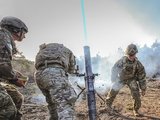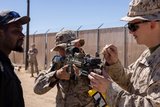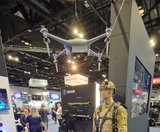Cubic tailors mortar simulator for the US Army
The company’s mortar trainer received improvements based on soldier’s feedback.
USS Bataan (LHD 5), a Wasp-class amphibious assault ship of the US Navy, has taken part in the two-week PHIBRON-MEU Integrated Training (PMINT) exercise off the East Coast of the US in September 2016.
The Bataan Amphibious Readiness Group (BATARG), 24th Marine Expeditionary Unit (MEU) and Amphibious Squadron (PHIBRON) 8 were part of the training exercise, along with the San Antonio-class amphibious transport dock USS Mesa Verde (LPD 19) and Harpers Ferry-class dock landing ship USS Carter Hall (LSD 50).
During PMINT, over 1,800 sailors from USS Carter Hall, USS Mesa Verde and USS Bataan, along with 1,400 marines from the 24th MEU, integrated to complete a series of exercises designed to improve interoperability between the sailors and marines.
Capt Eric N Pfister, commanding officer of USS Bataan, said: ‘The purpose of this exercise is the three ships, navy support elements and the MEU come together to work collectively in the same place, at the same time.’
During PMINT the embarked MEU personnel conducted integrated warfighting operations through air defence exercises, surface gunnery and communication scenarios and planning exercises.
PMINT includes a three-phase evolution. The first phase is embarkation, where marines and sailors work together to practice mission essential tasks such as tactical recovery of aircraft and personnel, transportation of vehicles and gear from shore to ship, amphibious assaults and flight deck qualifications.
Marines flew various helicopters for training, including the UH-1N Huey, CH-53E Super Stallion, AH-1 Cobra and MV-22B Osprey.
The next evolution for USS Bataan will be the midterm ARG/MEU exercise, where will have inspectors will grade the work performed, followed by the final phase, the Composite Training Unit Exercise.

The company’s mortar trainer received improvements based on soldier’s feedback.

The company will operate in two new locations in the coming years to better support US services.

This type of tool provides more realistic training easing the incorporation of new scenarios that accurately represent the threats of the battlefield.

The Engineering Corps has been conducting individual instruction using FLAIM Systems’ Sweeper and should start collective deployments in 2025.

The next-generation platform is motion-compatible and can be used in OTW and NVG applications.

The system can be used to prepare soldiers for both drone offensive operations and CUAS missions.